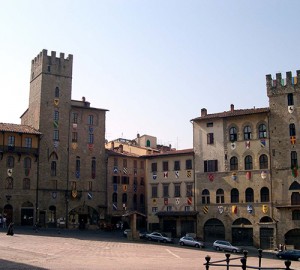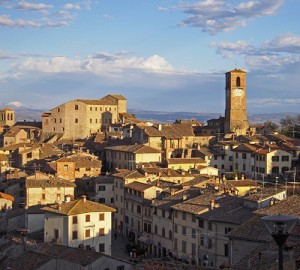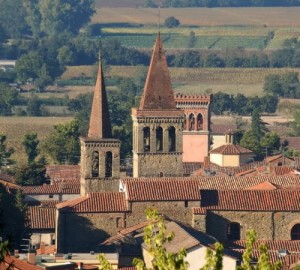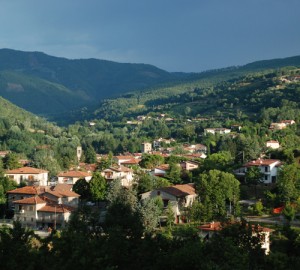Castiglion Fiorentino
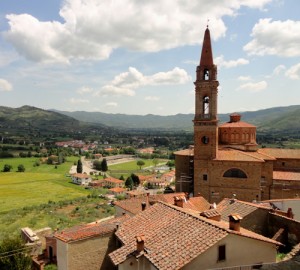 Castiglion Fiorentino is still surrounded by its medieval walls and is dominated by the old fort called Cassero. In the museum there are many paintings by Margaritone,Taddeo Gaddi, Bartolomeo della Gatta e Giorgio Vasari.
Castiglion Fiorentino is still surrounded by its medieval walls and is dominated by the old fort called Cassero. In the museum there are many paintings by Margaritone,Taddeo Gaddi, Bartolomeo della Gatta e Giorgio Vasari.
The position of the town offers a beautiful view on the surrounding valleys.
Culture, sport, music and gastronomy are the protagonists of many events that take place in the so called Maggio (May) Castiglionese. On the third Sunday in June a horse race takes place outside the walls.
.
Cortona
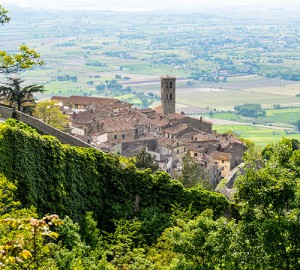 Cortona is certainly the pearl of the valley, its high position gives the visitors a wide view from lake Trasimeno to the southern mountains of Tuscany.
Cortona is certainly the pearl of the valley, its high position gives the visitors a wide view from lake Trasimeno to the southern mountains of Tuscany.
The Medieval atmosphere comes from its buildings and its typical streets full of craft shops. The most important sights are the Basilica of Santa Margherita, the Franciscan monastery of Le Celle, both situated in the highest part of the city. The Etruscan Museum, The City Hall, the Cathedral with the close museum (where some of Luca Signorelli’s and Beato Angelico’s paintings can be admired), are in the city centre. Two Etruscan tombs and a Hypogeous are situated at the bottom of the hill. One of the most important events for the city is the antique fair that takes place in a prestigious building of the historical centre from the last Sunday in August until the second Sunday of September. When driving in the direction of Foiano della Chiana you will meet the beautiful abbey of Santa Maria in Farneta which is one of the best expressions of the Romanesque style in the area of Arezzo.
Foiano della Chiana
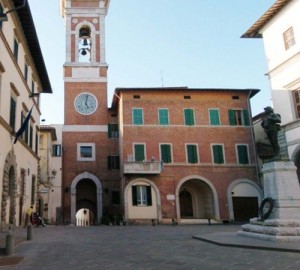 Foiano della Chiana is a city that dates back to the Etruscan and Roman times. It is situated at the centre of the valley and its historical centre, which is mainly in the renaissance style, is delimited by two city walls. The most important places are the church of SS.Trinita’ with a work by Pomarancio and the church of Santa Maria della Fraternita, which dates back to the XV century, and has a work by della Robbia. Outside the walls the Collegiata di San Martino is worth a visit for a work by Signorelli and a terracotta by della Robbia.
Foiano della Chiana is a city that dates back to the Etruscan and Roman times. It is situated at the centre of the valley and its historical centre, which is mainly in the renaissance style, is delimited by two city walls. The most important places are the church of SS.Trinita’ with a work by Pomarancio and the church of Santa Maria della Fraternita, which dates back to the XV century, and has a work by della Robbia. Outside the walls the Collegiata di San Martino is worth a visit for a work by Signorelli and a terracotta by della Robbia.
Then driving in direction of Pozzo della Chiana in an isolated place is situated the Temple of Santo Stefano della Vittoria, which was erected in the XVI century to celebrate the victory on Siena. In February and March Foiano is theatre of a famous Carnival.
.
Monte San Savino
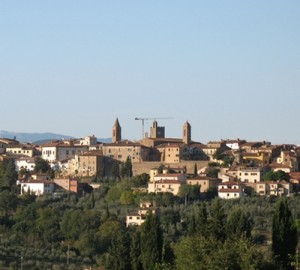 E’ uno dei centri più interessanti della Toscana per l’originale impianto castellano a pianta ellittica, racchiuso da mura con torri. Il borgo antico presenta, perfettamente conservati, il Palazzo Comunale, di origini duecentesche.
E’ uno dei centri più interessanti della Toscana per l’originale impianto castellano a pianta ellittica, racchiuso da mura con torri. Il borgo antico presenta, perfettamente conservati, il Palazzo Comunale, di origini duecentesche.
All’interno si trova un piccolo museo con dipinti di scuola senese e aretina oltre a una preziosa testimonianza dell’oreficeria tardogotica come il famoso “albero” reliquiario di Lucignano. Notevoli sono anche gli edifici religiosi quali la Collegiata e la Chiesa di San Francesco ornata di affreschi dei pittori senesi Bartolo di Fredi e Taddeo di Bartolo.
Di grande suggestione è quello situato sopra il primo altare nella navata destra, conosciuto come “Il Trionfo della Morte”, in cui, in modo efficace è rappresentata la precarietà della vicenda umana. La fantasia e l’estro dei suoi abitanti si manifestano in primavera, in occasione della Maggiolata Lucignanese dove i suoni e i colori dei fiori fanno rivivere una tradizione ricca di storia e di musica.
Lucignano
 Lucignano is very interesting for its castlelike plan, surrounded by walls with watchtowers. The most important building is the Town Hall, which dates back to the XIII century and has a museum with important paintings of artists from Arezzo and Siena.
Lucignano is very interesting for its castlelike plan, surrounded by walls with watchtowers. The most important building is the Town Hall, which dates back to the XIII century and has a museum with important paintings of artists from Arezzo and Siena.
The museum also keeps some examples of gold artworks and in particular the Lucignano reliquiary in the shape of a tree in Gothic style.
Some religious buildings, such as la Collegiata and the church of San Francesco have important paintings, among which the one called The Triumph of Death. In spring there is a famous event called Maggiolata Lucignanese where flowers and music are the protagonists.
